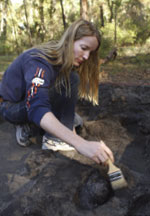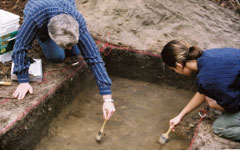The remnants of an Indian village destroyed by war almost two centuries ago reveal the Seminoles were actually blending into the American melting pot before they were driven to the swamps of South Florida, say Florida Museum of Natural History researchers.

Photo by Ray Carson
In a search for clues to what life was like for the Seminoles in the last North Florida town they occupied, museum archaeologists are finding diverse cultures and ways of life and are investigating the possibility of a surprising blend of European and American Indian architecture, said Jane Anne Blakney-Bailey, a University of Florida graduate student who is conducting the research for her doctoral dissertation under the supervision of Florida Museum archaeologist Jerald Milanich.
”The Seminoles are an excellent study of what happens when multiple cultures collide and how it affects the traditions of all societies involved,” Blakney-Bailey said. “This has a lot of relevance today because cultures are constantly forced to interact with one another, sometimes peacefully and sometimes in conflict.”
”Very few Seminole towns have ever been excavated in Florida,” Milanich said. “We’re interested in what the archaeology can tell us, because we’ve had to rely on historical documents to tell us about the Seminoles and their relations with the Anglos at that time.”
The excavations are taking place a few miles south of Gainesville within Paynes Prairie Preserve State Park. There, a team is unearthing Paynes Town, which was occupied from the 1790s until 1812, when U.S. soldiers killed 80-year-old King Payne, the village’s dynamic Seminole chief, in a devastating attack documented historically in a colonel’s diary.
So far, researchers have unearthed a wide variety of artifacts from the site that may help explain the merging of different cultural influences, Blakney-Bailey said. Different parts of ceramic vessels, dozens of multicolored glass beads, glass bottle fragments, lead musket shot, a belt buckle and pieces of silver jewelry are a few examples of the materials found that likely were obtained from Anglo traders, she said. More traditional materials also turned up, including animal bones, seeds, Seminole pottery and stone tools.
Also found, in a unique combination of the two material cultures, was a piece of manufactured brass sheet metal that had been molded into an arrowhead to meet Seminole needs, she said.
The Seminoles who lived at Paynes Town were once part of the Lower Creek Indians, inhabitants of the lower Chattahoochee River Valley of southern Alabama and Georgia, Blakney-Bailey said. Some of the Lower Creeks migrated into the Alachua Prairie in the mid-18th century, while the majority stayed in their native homeland.

Photo by Jane Domingez
”Although many aspects of the traditional Creek culture remained intact, Seminole life was influenced by several different cultures,” Blakney-Bailey said. “The Seminoles exchanged ideas and materials with other Indian tribes and escaped black slaves, as well as with Spanish, English and American settlers, all of whom changed Seminole culture in both subtle and dramatic ways.”
One part of daily life the archaeologists are examining at Paynes Town is the cultural change in the food patterns; what food the Seminoles preferred, how they acquired those preferences, their cooking and preparation techniques and the social rituals they developed around eating. Studies have shown that food habits often are slow to change.
”People emigrate to America, and even though they dress in American fashion, speak English and fit in mainstream society, at home they may eat traditional foods,” she said.
“I’m testing whether this holds true when there is great upheaval at the time of contact between aboriginal people and Europeans.”
”Historical documents describe Chief Payne as being a wealthy man, owning over a thousand head of cattle and living in an Anglo-style log cabin,” she said. “We’re searching for clues to corroborate these descriptions and want to learn how the rest of the town lived.”
The team has found traces of a burnt layer across a large area of the site four inches to a foot below the surface, and is trying to determine if it represents the town’s burning. The find makes a compelling case because the layer is present immediately on top of Seminole artifacts, indicating the burning event occurred extremely close to Seminole occupation of the town, Blakney-Bailey said.
The Paynes Town Seminoles and American soldiers fought in several military conflicts, and in the winter of 1812 the Americans set out to destroy the town, she said. Warned of the approaching danger by a black ally of the Seminoles, the Indian residents fled, and the soldiers stole food and livestock, burning the empty town as they left.
Learn more about the Florida Archaeology Collection at the Florida Museum.